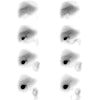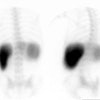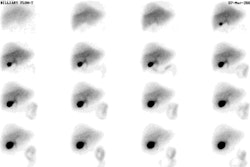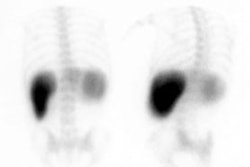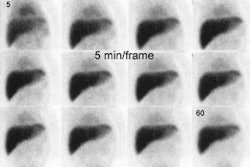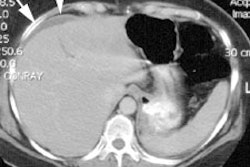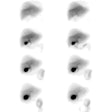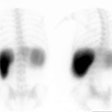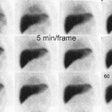Urea Breath Testing
By Dr. John Miliziano, MD
Helicobacter pylori is a gram negative rod discovered in 1983 and found to be associated with chronic gastritis. Associations with gastric adenocarcinoma and lymphoma have also been made. It is estimated that 80% of patients with non-NSAID induced gastric ulcers are infected with H. pylori [1] . Eradication of this infection with antibiotic therapy has been shown to decrease ulcer recurrence to <10% in one year versus a 60-100% one year recurrence with use of anti-ulcer medications alone [2].
Several methods other than breath testing are available for diagnosis of H. pylori to include serology testing and antral biopsy with histology, culture or urease (CLO) testing. Serology, while inexpensive and easy to perform is based on detection of antibodies (IgG and IgA) to H. pylori. This test is very sensitive to detection of past H. pylori exposure, however, it has the diasdvantage of remaining positive despite adequate treatment, thus it is not a reliable test for determining eradication. Histology, culture and CLO testing have as a disadvantage the requirement for endoscopy, an invasive and costly procedure. Urea breath testing, first developed in 1987 offers a non-invasive, qualitative means of detecting active H. pylori infection. This test requires the use of a 13C or 14C labeled urea capsule. Liquid forms of the test have been abandoned in favor of using capsules as a coating on the capsule prevents the urea from coming into contact with oral bacterial flora which if capable of producing urease could cause a false positive test. 13C has the advantage of being non-radioactive, however, its measurement requires use of a mass spectrometer which is not readily available. For this reason 14C ( T1/2= 5730 years) is the most widely used isotope today as measurement of this beta emitter can be made with a liquid scintillation counter.
PHARMACOLOGY: Urease is an enzyme not present in human cells, therefore its detection is evidence of a urease producing organism. Although H. pylori is not the only bacteria capable of producing urease it is the only bacteria commonly found in the stomach. The first step involves ingesting a 14C-Urea capsule. As the capsule comes into contact with the gastric mucosa, if urease is present it splits the urea into CO2 and NH3 . The CO2 is absorbed into the blood and exhaled in the breath as 14CO2. The breath sample contains maximum 14CO2 concentration between 10-15 minutes. The breath sample is then analyzed with a liquid scintillation counter.
INDICATIONS: The test is useful for initial diagnosis of H. pylori but more commonly used to document eradication or failure of initial therapy.
PATIENT PREPARATION:
1. Fasting for 6 hours prior to the test.
2. No antibiotic or bismuth use for 30 days prior to testing.
3. No proton pump inhibitors (Omeprazole, Lansoprazole) or carafate (Sucralfate) for 14
days.
4. No H2 blockers (Ranitidine, Cimetidine, famotidine) or antacids for 24 hours
prior to testing.
PROCEDURE: [3]
1. 14C-Urea capsule is swallowed with 20cc of water. ( the capsule should
not be handled or chewed (contact with oral flora may occur).
2. Obtain a 10 minute breath sample by asking the patient to hold the breath for 5-10
seconds then blow into the collection balloon and fill it completely.
*alternatively, breath collection can be made directly into the scintillation vial,
however, a safety trap must be used to prevent patient ingestion of the collection fluid
which contains hyamine ( caustic alkali) and methanol.
3. Measure activity in the breath sample with a liquid scintillation counter.
DIAGNOSTIC CRITERIA:
<50 dpm [Negative]
50-199 dpm [Indeterminate]
Results between 50-300dpm should be re-counted 24 hours later as chemiluminescence can temporarily produce a false increase in counts [Tri Med Specialties, Inc. User's Guide. www.trimed.com].
>/= 200 dpm [Positive]
INTERPRETATION:
Prior to performing the test, it is important to interview the patient and determine if
factors are present which will interfere with proper interpretation of the test.
| False Positive | False Negative |
| Gastric resective surgery / Achlorhydria which could cause bacterial overgrowth with non H. pylori bacteria. | Gastric resective surgery which leads to rapid gastric emptying of the test capsule. |
| Antibiotic therapy- relapse of infection may take 1-4 weeks. | |
| Proton pump inhibitors - suppress H. pylori in 40% of patients. |
SENSITIVITY / SPECIFICITY:
Comparison of the urea breath test with histology and CLO testing yields a sensitivity of 97% ( on initial examination histology had a sensitivity of 94% ) and specificity of 95%. Specificity may actually be higher as some cases called false positive by breath testing were actually false negative by histology. This study also compared sample analysis performed immediately with samples sent to Tri-Med and read at 72 hours. No significant difference in results was seen.[4]
RADIATION DOSIMETRY:
The critical organ for 14C-Urea is the urinary bladder with an effective
dose equivalent of 0.08 mSv.
| Bladder wall | HP- | HP+ | ||
| Female | .19mGy/MBq | .69rad/mCi | .14mGy/MBq | .5 rad/mCi |
| Effective dose equivalent. | .049mSv/ MBq | .18 rem / mCi | .08 mSv / MBq | .3 rem / mCi |
| Male | .14mGy/MBq | .52rad/mCi | .10mGy/MBq | .38 rad/mCi |
| Effective dose equivalent. | .038 mSv / MBq | .14 rem / mCi | .062 mSv / MBq | .23 rem / mCi |
* Stubbs JB, Marshall BJ. Radiation Dose Estimates for the Carbon-14-Labeled Urea Breath Test. JNM 1993;34:821-825.
REFERENCES:
(1) JAMA 1994; NIH Consensus Statement. Helicobacter pylori in peptic ulcer
disease. 272:65-69
(2) JAMA 1996; Soll AH. Consensus statement. Medical treatment of peptic ulcer disease-practice guidelines. 275:622-629
(3) J Nucl Med 1998; Balon H, et al. Procedure guideline for carbon-14-urea breath test. 38: 2012-2014
(4) Am J Gastroenterol. 1996; Peura DA. Et al. Microdose 14-C-Urea Breath Test Offers Diagnosis of Helicobacter pylori in 10 Minutes. 91(2):233-238
